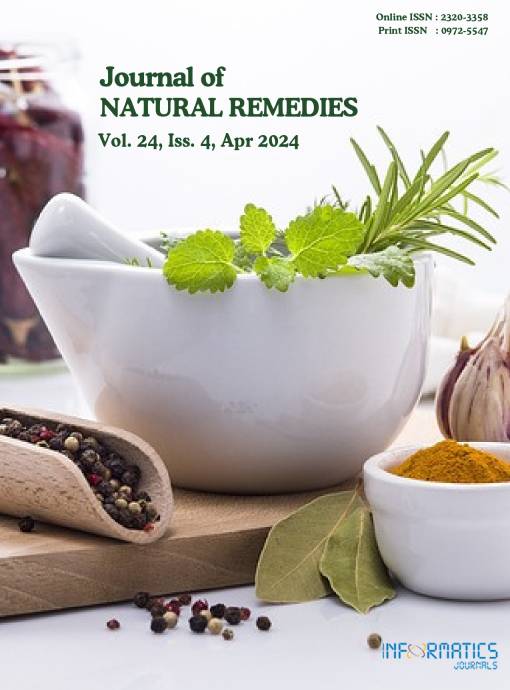Traditional Healing of Bone Fracture Complications Through Wild Plants in Hamirpur, India
DOI:
https://doi.org/10.18311/jnr/2024/34852Keywords:
Bone Fracture, Citations, Ethnomedicine, Informants, SurveyAbstract
Wild plants have a medicinal sense that can be applied to treat different ailments of the human body worldwide. They have been assessed for pharmacological, pharmaceutical, nutritional and ecological significance. In the present work, an effort has been made to conduct an ethnobotanical survey in the Hamirpur district, Himachal Pradesh from 2012 to 2019. Key informants were identified in the preliminary study and information was collected by conducting semi-structured and open interviews. The focus was primarily on the wild plant the residents used to treat bones and related complications for ages. The local people employed 23 main ethnomedicinal plant species belonging to 15 families for the same purpose. The Citation Frequency (CF) and Medicinal Importance Value (MIV) of wild plants were evaluated. It varied from 0.68 to 10.63 and 1.16 to 42.2, respectively. The highest CF was observed for Cissus quadrangularis (10.63) and lowest for Peristrophe bicalyculata (0.68), whereas the highest (42.12) MIV was calculated for Cissus quadrangularis and lowest (1.16) for Cleome viscosa. The present study found that Cissus quadrangularis, Tinospora cordifolia, Celastrus paniculata, Litsea glutinosa, Cuscuta reflexa, Soymida febrifuga and Osyris arborea are traditionally important ethno-medicinal plants for the treatment of bone problems, such as hematoma formation, inflammation and repair.
Downloads
Metrics
Downloads
Published
How to Cite
Issue
Section
License
Copyright (c) 2024 Ram Chand Bhatti, Sabir Hussain, Siril Singh, Himanika Bhatti (Author); Chongtham Nirmala; Anand Narain Singh (Author)

This work is licensed under a Creative Commons Attribution 4.0 International License.
Accepted 2024-02-15
Published 2024-04-01
References
Bhatti RC, Kaur R, Kumar V, Singh AN. Medicinal plants used in the treatment of ophthalmic diseases by local people of Hamirpur district, Himachal Pradesh. Int J Educ Res. 2016; 5(2):186-198.
Kumar S, Raj J, Chand R. An ethnobotanical study of important medicinal plants in Hisar District of Haryana. India. Int J Health Sci. 2022; 6:11195-200. https://doi.org/10.53730/ijhs.v6nS3.8620
Singh S, Roy D, Sinha K, Parveen S, Sharma G, Joshi G. Impact of COVID-19 and lockdown on mental health of children and adolescents: A narrative review with recommendations. Psychiatry Res. 2020; 293:113429. https://doi.org/10.1016/j.psychres.2020.113429
Hassan B, editor. Medicinal Plants: Use in Prevention and Treatment of Diseases. BoD-Books on Demand; 2020 Mar 25.
Singh V. Medicinal plants and bone healing. J Maxillofac. Surg. 2017; 8(1):4. https://doi.org/10.4103/0975-5950.208972
Abd Jalil MA, Shuid AN, Muhammad N. Role of medicinal plants and natural products on osteoporotic fracture healing. eCAM. 2012 Jan 1. https://doi.org/10.1155/2012/714512
Bhatti RC, Kaur R, Kumar V, Singh AN. Ethno-botanical survey on medicinal plants used in the treatment of Pile by local people from Hamirpur district, Himachal Pradesh. Int J Educ Res. 2017; 5(1):257-270.
Chand R, Kaur R, Kaur A, Kumar V, Nirmala C, Singh AN. Assessment of ethnomedicinal plant diversity of Una and Hamirpur district of Himachal Pradesh, India: an ethno-ecological approach. Ann Plant Sci. 2016; 5(12):1475-90. https://doi.org/10.21746/aps.2016.12.005
WHO (World Health Organization). National policy on traditional medicine and regulation of herbal medicines. Report of WHO global survey Geneva: World Health Organization. 2005.
Nayak BS, Suresh R, Rao AV, Pillai GK, Davis EM, Ramkissoon V, McRae A. Evaluation of wound healing activity of Vanda roxburghii R. Br (Orchidacea): A preclinical study in a rat model. Int J Low Extrem Wounds. 2005; 4(4):200-4. https://doi.org/10.1177/1534734605282994
Bhatti RC, Nirmala C, Kaur A, Singh S, Kumar P, Kaur R, Singh AN. Harnessing of local plant species by indigenous people of Hamirpur district for ethno-veterinary purposes. Ann Plant Sci. 2017; 6(12):1898-925. https://doi.org/10.21746/aps.2017.6.12.17
Upadhya V, Hegde HV, Bhat S, Hurkadale PJ, Kholkute SD, Hegde GR. Ethnomedicinal plants used to treat bone fracture from North-Central Western Ghats of India. J Ethnopharmacol. 2012; 142(2):557-62. https://doi.org/10.1016/j.jep.2012.05.051
Namsa ND, Tangjang S, Arya SC, Rajbonshi B, Samal PK, Mandal M. An inventory of the ethnobotanicals used as anti-diabetic by a rural community of Dhemaji district of Assam, Northeast India. J Ethnopharmacol. 2011; 138(2):345-50. https://doi.org/10.1016/j.jep.2011.08.018
Gulecha V, Sivakumar T, Upaganlawar A, Mahajan M, Upasani C. Screening of Ficus religiosa leaves fractions for analgesic and anti-inflammatory activities. Indian J Pharmacol. 2011; 43(6):662.
Bhakta T, Mukherjee PK, Saha K, Pal M, Saha BP, Mandal SC. Evaluation of anti-inflammatory effects of Cassia fistula (Leguminosae) leaf extract on rats. J Herbs Spices Med Plants. 2000; 6(4):67-72. https://doi.org/10.1300/J044v06n04_08
Ilavarasan R, Malika M, Venkataraman S. Anti-inflammatory and antioxidant activities of Cassia fistula Linn bark extracts. AJTCAM. 2005; 2(1):70-85. https://doi.org/10.4314/ajtcam.v2i1.31105
Rajeswari R, Thejomoorthy P, Mathuram LN, Raju KN. Anti-inflammatory activity of Cassia fistula Linn. bark extracts in sub-acute models of inflammation in rats. 2006. p. 193-199.

 Ram Chand Bhatti
Ram Chand Bhatti









 0.35
0.35 24
24 0.161
0.161